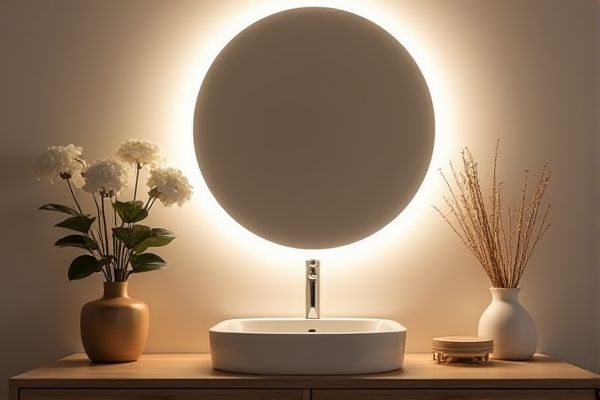
Lighted mirrors provide enhanced visibility by incorporating built-in LED lighting that evenly illuminates your reflection, reducing shadows and improving makeup application or grooming precision. Discover the benefits and key differences between lighted mirrors and standard mirrors to choose the best option for Your needs in the full article.
Table of Comparison
| Feature | Lighted Mirror | Standard Mirror |
|---|---|---|
| Lighting | Integrated LED or built-in lighting for enhanced visibility | No built-in lighting, relies on room light |
| Usage | Ideal for makeup, grooming, and precision tasks | General reflection and decoration |
| Power Source | Requires electricity or batteries | No power required |
| Cost | Higher price due to added features | More affordable and widely available |
| Design | Modern and functional design options | Varied designs, often simpler style |
| Installation | May require electrical work | Simple installation, hanging or mounting |
| Energy Efficiency | Uses low-energy LED lights | No energy consumption |
Introduction to Lighted vs Standard Mirrors
Lighted mirrors feature integrated LED lighting that enhances visibility and provides consistent illumination for detailed tasks like makeup application or shaving. Standard mirrors lack built-in lighting, relying solely on ambient room light, which may cast shadows and reduce clarity. Your choice impacts not only functionality but also the overall aesthetic and ambiance of your space.
Key Features of Lighted Mirrors
Lighted mirrors feature integrated LED lighting that provides consistent, shadow-free illumination, enhancing visibility and accuracy during grooming. These mirrors often include adjustable brightness levels and color temperatures, allowing you to customize lighting to suit various tasks and environments. Unlike standard mirrors, lighted mirrors combine reflective quality with functional lighting, improving both aesthetics and practicality in your daily routine.
Key Features of Standard Mirrors
Standard mirrors typically feature a flat glass surface with a reflective backing, commonly made from silver or aluminum. These mirrors provide clear, undistorted images suitable for everyday use in bathrooms, bedrooms, and dressing areas. Unlike lighted mirrors, they lack built-in illumination and rely on external lighting for visibility.
Brightness and Illumination Comparison
Lighted mirrors provide superior brightness and evenly distributed illumination compared to standard mirrors, enhancing visibility in low-light environments. Integrated LED lighting in lighted mirrors eliminates shadows and reduces eye strain, offering a clearer reflection for tasks such as makeup application and grooming. Standard mirrors rely solely on ambient room lighting, which often results in uneven brightness and less accurate visual detail.
Design and Aesthetic Appeal
Lighted mirrors enhance your space with integrated LED lighting that provides a modern and sleek design, creating a sophisticated ambiance that standard mirrors often lack. Their built-in illumination highlights facial features and adds a functional, decorative element to any room. Standard mirrors offer traditional styles but typically do not contribute additional lighting or visual enhancement, making lighted mirrors a superior choice for both aesthetics and practicality.
Installation and Space Requirements
Lighted mirrors feature built-in LED lighting that requires electrical wiring, making installation more complex and often necessitating professional assistance. Standard mirrors are typically simpler to install, needing only basic mounting hardware and minimal wall space. Your choice depends on available space and willingness to accommodate additional electrical setup for enhanced lighting.
Energy Consumption and Efficiency
Lighted mirrors incorporate energy-efficient LED technology, consuming significantly less power than traditional lighting setups required for standard mirrors, which rely on external light sources. Their built-in illumination provides consistent, bright lighting while minimizing electricity usage, making them ideal for eco-conscious households. You can reduce your energy consumption without sacrificing visibility by choosing a lighted mirror over a standard one.
Cost Differences and Value for Money
Lighted mirrors typically cost between $50 and $300 more than standard mirrors due to integrated LED lighting and additional electronics. The added expense often translates into better value for money by providing improved visibility and convenience, especially for tasks like makeup application or grooming. Investing in a lighted mirror enhances your daily routine by combining functionality and modern design, making it a worthwhile upgrade over standard mirrors.
Ideal Uses for Lighted and Standard Mirrors
Lighted mirrors are ideal for detailed grooming tasks such as applying makeup, shaving, or skincare routines, providing even illumination that reduces shadows and enhances visibility. Standard mirrors work best for general use in bedrooms, hallways, or bathrooms where natural or overhead lighting is sufficient. Your choice depends on whether precise lighting is essential for your daily routine or if a simple reflective surface meets your needs.
Choosing the Right Mirror for Your Space
Lighted mirrors provide enhanced visibility with built-in LED lighting that eliminates shadows, making them ideal for detailed tasks like makeup application and grooming. Standard mirrors offer a classic, versatile reflection without integrated lighting, allowing greater flexibility in placement and aesthetic customization. Selecting the right mirror depends on your space's lighting conditions and functional needs, balancing natural light availability with desired ambiance and clarity.
 homyna.com
homyna.com